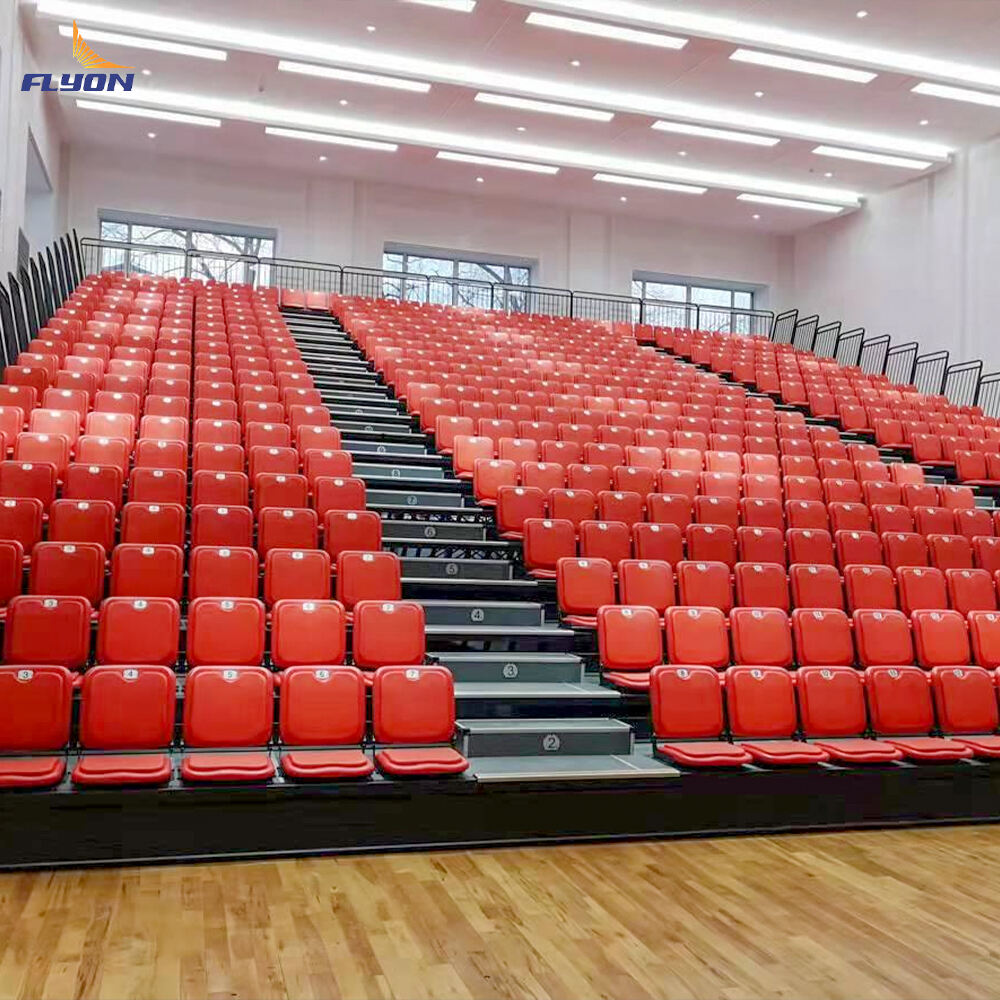Material Choices for Long-Lasting Playground Seating
Rubberized Compounds: From Running Tracks to Benches
Rubberized compounds have proven to be exceptionally durable, making them a preferred choice for playground seating and athletic tracks. These materials are renowned for their resilience, providing excellent shock absorption, which enhances safety for children engaging in active play. Additionally, the versatility of rubberized compounds allows for various design options — from vibrant benches to textured surfaces that improve grip. Their adaptability supports diverse aesthetic and functional requirements, thus transforming playgrounds into safer spaces for children.
Powder-Coated Steel vs. Aluminum Alloys
When considering playground seating, it's vital to compare the resilience of powder-coated steel with aluminum alloys. Both materials are highly durable but offer distinct advantages in outdoor settings. Powder-coated steel boasts improved aesthetic appeal and rust resistance, while aluminum alloys offer lightness and robustness. Statistics show that powder-coated steel can last several decades with minimal maintenance due to its protective layer, as confirmed by industry experts. Meanwhile, aluminum alloys are favored for their lightweight nature, which can reduce overall installation costs.
Recycled Plastics Meeting Tartan Track Standards
In recent years, there has been a growing trend of integrating recycled plastics into playground seating, emphasizing sustainability. Such materials meet performance standards akin to traditional tracks, ensuring safety and durability for users. These eco-friendly options not only offer environmental benefits but also enhance playgrounds’ aesthetic appeal. Products made from recycled plastics, such as seating and play equipment, provide durability comparable to other materials, and contribute positively to efforts in reducing environmental waste.
Ergonomic Designs Supporting Young Bodies
Backrest Angles for Proper Posture Alignment
Proper backrest angles are crucial for supporting posture and comfort during extended periods of sitting, especially for children in playground settings. Ergonomic designs tailored to children's needs can prevent back pain, a common issue identified through medical research linking poor posture to discomfort. By implementing ideal backrest angles, we can ensure that children's seating encourages healthy posture, thus minimizing the risk of back pain. Examples in design showcase how adjustable angles enhance comfort, promoting both immediate ease and long-term health benefits, crucial in playground environments where children frequently interact and play.
Height-Adjustable Seating for Growing Students
Height-adjustable seating plays a vital role in accommodating the diverse and changing needs of growing students. It supports adaptability for different age groups, ensuring ergonomic comfort and promoting engagement in activities both in playgrounds and educational settings. Educational ergonomics research emphasizes the importance of such adaptability, correlating it with better physical and mental engagement among various age groups. Listing the benefits, height-adjustable seating not only supports comfort but also encourages sustained interaction, supported by classroom data showing improved focus and participation.
Contoured Edges Preventing Pressure Points
Contoured edges are essential in playground seating design as they help to reduce pressure points, enhancing overall comfort during play. Studies focusing on child comfort reveal that discomfort is significantly reduced with well-designed, contoured edges, a key aspect in ensuring enjoyable and sustained playground interaction. By comparing seating featuring rounded and contoured edges to standard designs, we see increased user comfort and improved satisfaction, providing better support and reducing pressure on sensitive areas, thereby enhancing children's play experiences and sustaining their involvement.
Safety-First Seating Installation
CPSC Anchoring Guidelines for Stability
Ensuring the stability of playground seating is paramount, and the Consumer Product Safety Commission (CPSC) guidelines offer crucial insights for proper installation. These guidelines emphasize the importance of robust anchoring techniques to prevent tipping, thereby enhancing the safety of children during play. According to safety statistics, proper anchoring significantly reduces accidents linked to playground equipment instability. To comply with CPSC standards, one should follow a meticulous installation process that includes selecting appropriate anchoring materials, using certified installation tools, and performing regular maintenance checks. By adhering to these measures, one can create a stable and secure environment that supports safe play for all youth track team enthusiasts.
Impact-Absorbing Surfaces Under Seating Areas
Impact-absorbing surfaces are vital in minimizing injury risks associated with playground falls, ensuring children's safety while having fun. Various surfacing options, such as rubber mats, synthetic turf, and engineered wood fibers, have been studied by playground safety experts for their effectiveness. Empirical research shows that these materials can significantly reduce the impact of falls, thereby lowering injury rates among children. When assessing existing surfaces for potential upgrades, it is crucial to check for wear and tear, evaluate the cushioning properties, and ensure compliance with industry standards. Implementing these impact-absorbing surfaces can greatly enhance the safety environment in areas like youth track teams, where active play is encouraged.
Clearance Zones Around Sports Equipment
Establishing appropriate clearance zones around playground seating and sports equipment is essential to promoting safe movement for children. Inadequate spacing can lead to higher accident rates, with case studies indicating that well-planned layout designs reduce injury risks significantly. According to these reports, maintaining a clear distance between structures allows for freer movement and reduces collision occurrences. Best practices in spatial design include respecting recommended clearance distances, ensuring unobstructed walkways, and positioning equipment to maximize visibility and supervision. By integrating these strategies, playgrounds can offer a safe, engaging experience for young athletes involved in activities such as track clubs and running, supporting their physical and social development seamlessly.
Age-Appropriate Configurations
Preschool: Low-Profile Seats with Armrests
For preschoolers, incorporating low-profile seats with armrests is essential to ensure safety and accessibility in seating arrangements. These design features accommodate the young age group's developmental needs by offering a stable and manageable seating height. Armrests are indispensable as they provide the necessary support for young children who are still mastering the skill of sitting independently. In a case study involving a preschool in Los Angeles, such seating designs significantly aided children transitioning from activity to rest, fostering an environment conducive to skill development. These arrangements align with the fundamental principles of preschool seating and low-profile furniture, ensuring a safe and engaging learning space.
Elementary: Collaborative Group Bench Designs
In elementary schools, the trend is shifting towards collaborative group bench designs to enhance community and interaction among students. The design options for these benches are varied, often aimed at encouraging group activities in line with educational goals. These benches serve as spaces where children can engage in discussions, work on projects, or simply take a break together. Such collaborative seating not only supports educational initiatives but also stands strong on factors like durability and ease of cleaning — crucial aspects in environments with high usage like schools. This approach promotes a sense of belonging while addressing practical needs through furniture design that reflects the principles found in collaborative benches and elementary school furniture.
Middle School: Stadium-Style Seating for Events
Stadium-style seating is an ideal choice for middle schools, especially during larger gatherings, as it encourages participation and engagement among students. This seating arrangement offers multiple benefits, such as enhanced visibility, comfort, and potential for multipurpose use within middle school environments. Stadium-style seats are well-suited for a range of activities, from assemblies to sports events, enabling all students to have an unobstructed view and enjoy a communal experience. Schools like Cedar Valley Middle School have successfully integrated this seating configuration, finding it beneficial for fostering inclusivity and efficient use of space. This concept efficiently utilizes stadium-style seating and resonates with the needs of middle school events, providing compelling examples of its successful implementation.
Integrating Seating with Playground Layouts
Shade Placement Near Youth Track Team Areas
Strategically placing shade near playground areas is crucial for protecting children during sunny play and sports activities. Research underscores the necessity for shade in reducing harmful UV exposure and preventing overheating, especially near active zones like youth tracks. When planning shade structures, it is important to consider inclusive options that can accommodate various playground configurations and integrate seamlessly with existing layouts. Ideally, shade should be placed over seating areas and tracks to encourage safe play while offering cool resting spots between activities.
ADA-Compliant Pathways to Seating Zones
Ensuring ADA compliance in playground design is essential for creating accessible seating areas for children with disabilities. ADA guidelines specify requirements for pathways that connect seating zones, ensuring they are wide enough to accommodate wheelchairs and other mobility aids. These pathways should have slip-resistant surfaces and minimal slope to enhance accessibility. An inclusive design promotes community engagement by allowing children of all abilities to interact and participate in group activities, fostering a sense of belonging and enhancing social interaction.
Modular Designs for Multi-Use Spaces
Modular seating designs offer versatility and adaptability for multi-use playground spaces. These designs allow seating to be adjusted or rearranged to suit various activities and age groups, optimizing the usage of available space. Modular systems can easily transition between different setups, such as seating for sports events or casual gatherings. Many schools have successfully utilized modular furniture to accommodate shifting needs, balancing functionality with aesthetic appeal to create dynamic environments suitable for diverse play activities.
Maintenance Strategies for Year-Round Use
Ensuring the durability of playground seating materials is essential for year-round use, and one effective strategy is applying weather-resistant coatings. These coatings protect surfaces from harsh weather conditions, significantly extending the lifespan of playground furniture. Research indicates that high-quality coatings can withstand extreme temperatures, prevent moisture penetration, and resist UV damage, which can save on replacement costs over time. It's vital to choose products from reputable manufacturers who offer proven solutions for various climates, ensuring reliable performance regardless of environmental challenges.
Implementing effective cleaning protocols is crucial for maintaining hygiene on high-touch surfaces in public playgrounds. With constant use by children, these areas require regular sanitization. The Centers for Disease Control and Prevention (CDC) recommends using EPA-approved disinfectants for cleaning frequently touched surfaces. Establishing a thorough cleaning routine that includes a checklist of essential materials is vital. Popular disinfectants should be applied at recommended intervals to ensure optimal hygiene and minimize the spread of germs, contributing to a safer play environment for all children.
Readily available replacement parts are critical for ongoing maintenance of playground seating, ensuring longevity and functionality. The average lifespan of various components varies, with some parts requiring more frequent replacement due to wear and tear. Statistics show that having a stock of essential parts can reduce downtime and enhance safety. To find reliable suppliers, explore user reviews and recommendations from trusted industry sources, ensuring that you can swiftly address any maintenance needs without compromising the quality of the playground experience.
 EN
EN
 AR
AR
 FR
FR
 PT
PT
 RU
RU
 ES
ES
 BG
BG
 HR
HR
 CS
CS
 DA
DA
 NL
NL
 FI
FI
 DE
DE
 EL
EL
 HI
HI
 IT
IT
 JA
JA
 KO
KO
 NO
NO
 PL
PL
 RO
RO
 SV
SV
 CA
CA
 TL
TL
 ID
ID
 SR
SR
 SK
SK
 UK
UK
 VI
VI
 HU
HU
 TH
TH
 TR
TR
 MS
MS
 AZ
AZ
 KA
KA
 BN
BN
 LO
LO
 MN
MN
 MY
MY
 UZ
UZ


